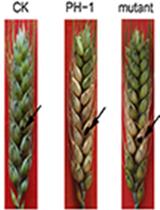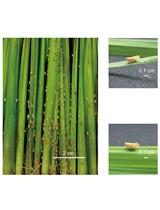- EN - English
- CN - 中文
Penetration Assays, Fungal Recovery and Pathogenicity Assays for Verticillium dahliae
大丽轮枝菌的渗透测定、真菌恢复和致病性测定
发布: 2017年02月20日第7卷第4期 DOI: 10.21769/BioProtoc.2133 浏览次数: 11195
评审: Arsalan DaudiGazala AmeenVenkatasalam Shanmugabalaji
Abstract
Verticillium dahliae is a soil-borne phytopathogenic fungus that infects host roots and proliferates in vascular tissues. The great loss of economically important crop caused by V. dahliae has raised worldwide concern, however, little is known about the mechanism of its pathogenicity (Klosterman et al., 2011; Yadeta and Thomma, 2013). Our recent work has shown that V. dahliae develops hyphopodium as an infection structure to breach plant root cell wall (Zhao et al., 2016). Here, we provide a detailed protocol to analyze the penetration ability and the pathogenicity of V. dahliae as well as recover fungal hyphae from infected cotton stems developed from our previous studies (Zhang et al., 2016a and 2016b; Zhao et al., 2016). Cellophane membrane has been used in inducing appressorium development of foliar pathogens but not root pathogens (Bourett and Howard, 1990). We adopted the method of using the cellophane membrane to induce and assess the development of hyphopodium. Hopefully, it will greatly promote the research of molecular events involved in recognition of the host that regulate infectious development. This protocol is also helpful to identify the key component controlling the pathogenicity of V. dahliae and widen our understanding of the mechanism of plant-microbe interaction.
Keywords: Verticillium dahliae (大丽轮枝菌)Background
The cellophane membrane has been widely used to study the development of infection structure in foliar pathogens (Bourett and Howard, 1990; Kleemann et al., 2012; Gu et al., 2014), we firstly adopt this method to induce infection structure in root pathogen of V. dahliae, which is a simple and efficient method to study the hyphopodium development. Also, we previously developed a novel unimpaired root dip-inoculation method to assess the pathogenicity of V. dahliae in cotton (Gao et al., 2010). The regular procedure for infection of plants with the soil-borne pathogen is to uproot soil-grown plants, incubate the roots in a conidial suspension, and then replant the plants in fresh soil. Our inoculation method avoids damaging the roots and is convenient for operation, which combined the protocol of fungal recovery from stem facilitates the pathogenicity study of soil-borne pathogens that colonize the vascular tissues.
Materials and Reagents
- Protection gloves (Medicom, catalog number: 1174D )
- Protection coat (Medicom, catalog number: 8018 )
- Cellophane membrane (DINGGUO CHANGSHENG, catalog number: XH444-1 )
- Round (90 mm diameter) Petri dishes (Thermo Fisher Scientific, Thermo ScientificTM, catalog number: 101VIRR )
- Sterilized gauze (Thermo Fisher Scientific, Fisher Scientific, catalog number: 22-415-469 )
- Pot for cotton growth (Shantou Xing Lv Yuan, dimensions: 300 x 200 x 100)
- Sterilized pipette tips (Corning, Axygen®, catalog number: TF-1005-WB-L-R-S )
- 50 ml conical tubes (Corning, catalog number: 430828 )
- Cotton seeds (Nongqishi Agricultural Institute, cv. Xinluzao NO.16)
- Potato tubers
- Glycerol
- Distilled water (Milli-Q) (EMD Millipore, catalog number: QTUM00ICP )
- 70% (v/v) ethanol (EtOH in ddH2O)
- 30% H2O2 (ALADDIN, catalog number: H112519 )
- Glucose (Sigma-Aldrich, catalog number: V900392 )
- Agar (BD, BactoTM, catalog number: 214010 )
- Sodium nitrate, NaNO3 (EMD Millipore, catalog number: 106537 )
- Potassium dihydrogen phosphate, KH2PO4 (EMD Millipore, catalog number: 104873 )
- Potassium phosphate dibasic, K2HPO4 (Sigma-Aldrich, catalog number: V900050 )
- Magnesium sulfate heptahydrate, MgSO4·7H2O (EMD Millipore, catalog number: 105886 )
- Potassium chloride, KCl (EMD Millipore, catalog number: 104933 )
- Sodium citrate (Sigma-Aldrich, catalog number: V900095 )
- Zinc sulfate heptahydrate, ZnSO4·7H2O (Sigma-Aldrich, catalog number: Z4750 )
- Iron(II) sulfate heptahydrate, FeSO4·7H2O (Sigma-Aldrich, catalog number: V900038 )
- Ammonium iron(III) sulfate dodecahydrate, NH4Fe(SO4)2·12H2O (Sigma-Aldrich, catalog number: V900032 )
- Copper(II) sulfate pentahydrate, CuSO4·5H2O (Sigma-Aldrich, catalog number: C7631 )
- Manganese(II) sulfate monohydrate, MnSO4·H2O (Sigma-Aldrich, catalog number: V900271 )
- Boric acid, H3BO3 (Sigma-Aldrich, catalog number: V900267 )
- Sodium molybdate dehydrate, Na2MoO4·2H2O (EMD Millipore, catalog number: 106521 )
- Sucrose (Merck Millipore, catalog number: 107687 )
- Murashige and Skoog (MS) medium including vitamins (Duchefa Biochemie, catalog number: M0222 )
- Potato dextrose agar (PDA) (see Recipes)
- TES (see Recipes)
- Minimal medium (MM) (see Recipes)
- MS liquid medium (see Recipes)
- Czapek-Dox medium (see Recipes)
Equipment
- Heat plate and cooking pot to boil potatoes (Supor, catalog number: SDHC8E15 )
- Flasks and magnetic stirrer for preparation of solutions (Thermo Fisher Scientific, Fisher Scientific, catalog number: S88850206 )
- Fungal growth incubator (SAIFU, catalog number: MJX-450S )
- 26 °C incubator shaker (Zhicheng, catalog number: ZHWY-2102C )
- Autoclave (Hirayama, catalog number: HVE-50 )
- Clean bench (Zhicheng, catalog number: ZHJH-C1209B )
- Hemocytometer for conidia counting (Qiujing, catalog number: QJ1102 )
- Rotator (Qilinbeier, catalog number: QB-208 )
Procedure
文章信息
版权信息
© 2017 The Authors; exclusive licensee Bio-protocol LLC.
如何引用
Zhao, Y., Zhang, T. and Guo, H. (2017). Penetration Assays, Fungal Recovery and Pathogenicity Assays for Verticillium dahliae. Bio-protocol 7(4): e2133. DOI: 10.21769/BioProtoc.2133.
分类
植物科学 > 植物免疫 > 病害生物测定
细胞生物学 > 组织分析 > 组织染色
您对这篇实验方法有问题吗?
在此处发布您的问题,我们将邀请本文作者来回答。同时,我们会将您的问题发布到Bio-protocol Exchange,以便寻求社区成员的帮助。
提问指南
+ 问题描述
写下详细的问题描述,包括所有有助于他人回答您问题的信息(例如实验过程、条件和相关图像等)。
Share
Bluesky
X
Copy link













